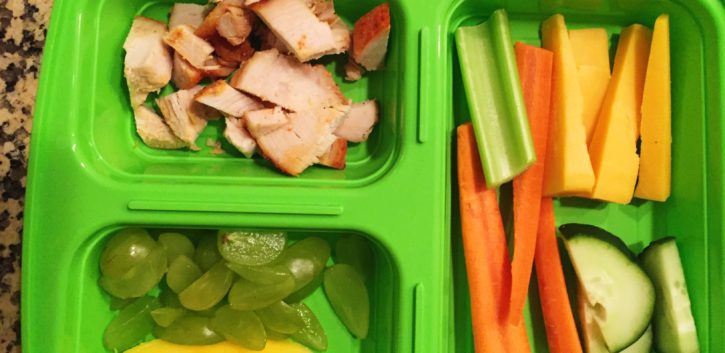I love sharing what I’m feeding my kids (hence the passion behind Mommy Feeding Family), and I often share my meal plans, pictures and instructions for what I put in my kids’ lunches, and more on social media. If you follow me on SnapChat (@AshleySweeneyRD) you’ve probably seen those cute lunch boxes I use… sSo what’s inside of those lunch boxes? Deciding how to pack those lunches can sometimes cause some serious brain fog. Let me help you navigate the lunch box dilemma! See Part 2 for examples!
Weekly Lunch Packing Steps:
- Get your lunch boxes ready.
- Plan your family dinners for the week.
- Determine which dinners would make for easy leftovers for lunches (for yourself and the kids).
- Pack bulk items into individual serving baggies (veggie straws, crackers, seeds, nuts, etc,)
- Wash, dry, chop and portion veggies into individual serving baggies or lunch boxes.
- Keep extra veggies washed & chopped in the fridge for easy after school snacks.
- Make sure every day of lunches has at least one serving of veggies.
- Make sure every day of lunches has some healthy fats (see some examples below).
- Include a source of filling protein (see below).
- Add the right carbs. Traditional cookies, crackers, chips, juices, etc. are only going to give your child a rush of added sugar. Make sure that the carbs in your kids lunches are full of fiber, vitamins and minerals!
Lunch Box Tips:
- Pack a few days of dinner at once.
- Meal planning & prepping is key, as you can always plan for dinner to be tomorrow’s lunch!
- Pack it the night before! While you’re fixing dinner plates have the lunch containers out and ready. Two birds one stone! OR you could pack lunches for the week during your meal prep.
- Don’t forget the ice packs. Food safety is always important especially with the little ones.
- Stock up on lunch containers. I love using these ones. I will say, while they work fine, they aren’t amazing quality. I know that. They work for me because they are cheap, I can get them in bulk to make a few days worth at the same time,
- Avoid introducing new foods for school lunches. Save these foods for family dinners.
- Be prepared for food waste. Lots of times kids are too distracted and having too much fun to eat so don’t fret if food comes back home.
Now that we have some tricks on how to pack those lunch boxes, let’s talk about what to pack. Make sure all of your bases are covered by including a protein, fat, and carbohydrate source for each lunch. Here are some ideas to jog your creativity and keep it interesting for the munchkins.
Protein
Protein choices includes meat, nuts, seeds, and beans. Fill those lunch boxes with any of the following: chicken (sliced, diced, shredded, etc.) roasted deli meat*, meatballs, cooked taco meat, boiled eggs, almond or peanut butter/sunflower butter sandwich, yogurt, or any type of beans your child enjoys. *Note: I recommend antibiotic-free, no nitrite/nitrate meat, organic deli meat only every now and then.
Carb (fruit & veggies)
Be sure to add veggies and fruits! Healthy options include: strawberries, blueberries, grapes, orange slices, a banana, apple slices, apple sauce, cherry tomatoes, carrot sticks, cucumber rounds, roasted broccoli, cubed sweet potatoes, sliced mushrooms, green beans, and celery sticks. Tip: You can put frozen berries in the lunch box they will still be cool by lunch time.
Fat
Fat doesn’t necessarily need to have it’s on section in the container, because it’s usually incorporated in other foods. For example, fats are included in foods like the chicken prepared in oil olive, a peanut butter sandwich, a spread of avocado on a sandwich, olives, nuts & seeds, full-fat dairy, or the carrots steamed with butter. If need, you can add some raw nuts or avocado chunks, but be sure to squeeze some lemon over the avocado chunks to prevent browning. My littlest is obsessed with the Wholly Guacamole individual serving packets! Since our school is a nut free school, it can feel like a challenge sometimes. Here are our favorite healthy fat options:
- Seed mix or trail mix with sunflower seeds, pumpkin seeds, or Sacha inch seeds.
- Guacamole or avocado
- Organic full fat cheese
- Hummus
Dips
Dips are a fun, interactive way to incorporate healthy items in those lunch boxes. Try peanut butter for the celery sticks, a savory yogurt, guacamole, or hummus for the carrots and cucumbers, BBQ sauce or ketchup for the chicken pieces. *Note: look for sauces without high-fructose corn syrup.
Something They Like
Try to include something you know your kids enjoy in their lunch boxes such as animal crackers, cheese crackers, dark chocolate pieces, low-sugar granola or a granola bar, fruit snacks, pickles, homemade trail mix, or non-gmo popcorn.
Tip: I like to include something I know my girls will enjoy as a little treat, especially if it’s a jittery time in the school year such as testing week, first day of school, first day back after holiday, etc. And don’t forget the sweet note! Even if it’s just a smiley face or sticker for the little ones that can’t read yet!
When it comes to children’s nutrition, focus on having an overall healthy week. Try not to stress too much about each and every lunch box. It’s one meal out of many, and you can fill in the nutritional gaps the rest of week. You’re doing a good job, Mama! Keep up the good work!
